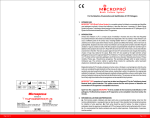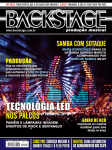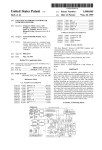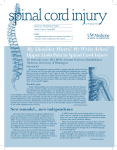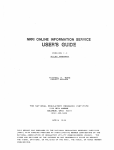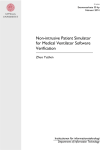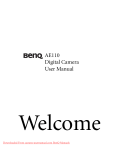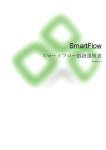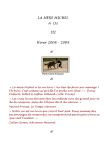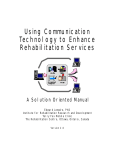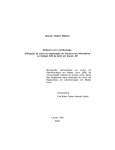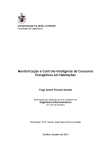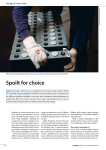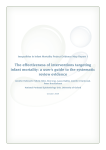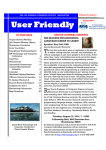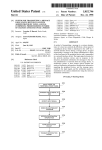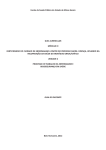Download User`s Manual for PEER VIII (print edition) Online
Transcript
User’s Manual for PEER VIII (print edition) Online Testing Site and PEER VIII Online July 11, 2012 Questions? Read the User’s Manual. Read “Frequently Asked Questions” here and here. Call the ACEP Member Care Center Monday through Friday, 8 to 5 Central, 800‐798‐1822. E‐mail us at [email protected]. Here’s the ACEP Privacy Policy. Computer system requirements: a computer or mobile device with an Internet connection and a standard browser (Internet Explorer, Safari, Firefox, Chrome); also, Adobe Reader and connection to a printer if you want to view and print your reports or CME certificates. CME Credit Information for PEER VIII Online Date of review by CME provider: April 11, 2012 Release date: July 11, 2012 Expiration date: October 14, 2014 Learner Objective: On completion of PEER VIII Online, you should be able to demonstrate cognitive expertise on topics from “The Model of the Clinical Practice of Emergency Medicine” and preparation sufficient to pass an emergency medicine written certification examination. Accreditation Statement: The American College of Emergency Physicians is accredited by the Accreditation Council for Continuing Medical Education to provide continuing medical education for physicians. Designation Statement: The American College of Emergency Physicians designates this enduring material for a maximum of 55 AMA PRA Category 1 Credit(s)TM. Physicians should claim only the credit commensurate with the extent of their participation in the activity. Approval Statement: Approved by the American College of Emergency Physicians for 55 hours of ACEP Category I credit. Approved by the American Osteopathic Association for 55 hours of AOA Category 2‐B credit (requires passing grade of 70% or better). Target Audience: PEER VIII Online is designed for emergency physicians. Please note: CME credit can be claimed for the PEER VIII print edition and PEER VIII Online only once per subscriber, per format. There is no CME credit for the free PEER VIII Pretest. How to Get Started Go to: www.acep.org/PEERVIIITesting Log in with your ACEP Username and Password. If you don’t know what they are, follow the links or call 800‐798‐1822. Go through all four phases of the educational activity in this order: o Phase 1: Self‐Assessment (Pretest) The first time you log in, you’ll go to Pretest. You’ll do Pretest only once, even if you purchase both the PEER VIII print edition and PEER VIII Online. On subsequent logins, you’ll go to the Main Menu. If you’re an ACEP member taking the free PEER VIII Pretest, you’ll have access to Phase 1 only. If you purchase PEER VIII, your Pretest scores will be retained. o Phase 2: Study and Practice o Phase 3: Post‐Test o Phase 4: Evaluation Page 1 of 18 How to Do Phase 1 Read the instructions on the screen. Click both attestation statements after reading the User’s Manual. Answer the questions closed book. (Read the stem and answer set, choose one best answer, click its letter, then click “OK.”) o You don’t have to answer all 90 questions in one sitting. Every question screen has a button that says “Quit and Return to Main Menu.” If you want to stop, click it. o When you want to start again, log in. You’ll go to the Main Menu. Scroll down to the grid and click the green “Resume” icon for Pretest to pick up where you left off. Or, click “Phase 1” in the black navigation bar at the top of the screen. o After you answer all 90 Pretest questions, your score report will appear. Your overall score will be at the top, followed by your results by category, followed by your results by acuity and age modifier. You can save your results as a PDF. You can also look at them anytime from the Main Menu. Click “Main Menu” or “Phase 2 Menu” to proceed. If you’re an ACEP member taking the free PEER VIII Pretest, you can purchase PEER VIII or go to “Main Menu” or exit by closing your browser. How to Do Phase 2 Read the instructions on the screen. Put your mouse over the words “Phase 2: Study and Practice” in the black navigation bar to get the drop‐down menu. Pick a category and click it to begin. o How should you pick a category? You can go through them in the order they appear. Or you can start with the category you did best in on the Pretest – or the worst. The purpose is to study and practice in each category at least once to improve your cognitive expertise. Read the stem and answer set, choose one best answer, click its letter, then click “OK.” Look below the answer set – and below the image, if there is one – to see whether you’re right. o Don’t hit the “Back” button on your browser – it will lower your score. Remember, this is study and practice – a low score in this phase won’t keep you from getting CME credit. Study the answer explanations. This is a key component of the educational activity: each explanation is an essay on the topic. It explains the correct answer, but it also explains why the “foils” are not correct. This will better prepare you to answer other questions on the same topic, whether later in PEER VIII or on an actual exam. o If you purchased the PEER VIII print edition, the explanations are in your “Answers” book; the number in parentheses in the blue bar on the screen corresponds to the answer number in the text. (To see which questions are in each category, go to the “Question Numbers by Category” key in the “Testing Information” tab.) o If you purchased PEER VIII Online, the explanations appear on the screen. If there’s an image, you’ll have to scroll past it to read the explanation. Click “Next” to move to the next question. Click “Quit and Return to Main Menu” to stop answering questions. o Remember to check the Main Menu to see which tests you’ve started (you’ll probably have to scroll down to see it). From there you can review, retake, and resume your Phase 2 practice tests as many times as you want, even after you finish PEER VIII and/or PEER VIII Online and generate your CME certificate. After you’ve been through all 20 categories and you’re ready to try the Post‐Test, click “Phase 3: Post‐Test” from the black navigation bar on the Main Menu. How to Do Phase 3 Read the instructions on the screen. Click the attestation statement. o If you purchased both the PEER VIII print edition and PEER VIII Online, choose which activity’s Post‐Test you want to work on. Answer the questions closed book. Page 2 of 18 You’ll see whether you’re right when you click “OK,” but don’t hit the “Back” button on your browser – it will lower your score and we can’t fix it. Just click “Next” to move to the next question. o You don’t have to answer all 450 questions in one sitting. Every question screen has a button that says “Quit and Return to Main Menu.” If you want to stop, click it. o When you want to start again, log in. You’ll go to the Main Menu. Scroll down to the grid, then click the “Resume” icon next to the “Practice Post‐Test” you were working on to pick up where you left off. If you want to start over from question 1, click the “Retake” icon. o Be sure to read and understand the “Retake” and “Resume” commands before you click them: we can’t reset any of your test results or override anything you click or save. If you don’t like a practice test score, your only recourse is to retake it. After you answer all 450 Post‐Test questions, your score report will appear. It will show you how you did overall, in each category, and in the acuity frames and age modifiers. It will also show you how you did compared to your Pretest results. Remember, you must score 75% or higher to get the CME credit certificate. o If you want to save this test as your final result, click “Save as Final Post‐Test and Go to Phase 4: Evaluation.” Remember, final means final – if you save this result, we can’t un‐save it or reset it for you. o If you do not want to save this test as your final result, click “Save as Practice Post‐Test and Return to Main Menu.” Remember, you can take a practice post‐test as many times as you want from the Main Menu by clicking the “Retake” icon, but you can take your Final Post‐Test only once. After you save your Final Post‐Test, you’ll go to the evaluation. o How to Do Phase 4 Answer all 10 questions. Read the instructions at the end of the evaluation and click Submit. Read the recap of your Final Post‐Test and the information that will appear on your CME certificate. To get your CME certificate, click “Generate CME Certificate” then follow the instructions in the ACEP CME Tracker. Terms of Subscription Read these Terms of Subscription carefully. By attesting that you have read the User’s Manual and agree to all terms in it, or by using the Subscription, you (“Subscriber”) agree to these Terms of Subscription. You are a Subscriber if you are authorized to use PEER VIII Online or the online testing site for the PEER VIII print edition. These Terms of Subscription constitute an agreement (“Agreement”) by and between the American College of Emergency Physicians (“ACEP”) and each Subscriber of the online testing site for the PEER VIII print edition and of PEER VIII Online. Definitions “Account” refers to the Subscription plans and features selected by Subscriber through the ACEP Bookstore or Member Care Center at the time of purchase and accepted by ACEP, as such plans and features may change as set forth herein, as recorded by ACEP. “Effective Date” refers to the purchase date of the Subscription as listed in Subscriber’s Account. “Materials” refers to written and graphical content provided by or through the Subscription, including, without limitation, text, photographs, illustrations, and designs, whether provided by ACEP or any other third party. “Subscriber Data” refers to data in electronic form input or collected through the Subscription by or from Subscriber. “Privacy Policy” refers to ACEP’s privacy policy; posted at www.acep.org as such policy may change from time to time. “Subscription” refers to the online testing site for the PEER VIII print edition, or to PEER VIII Online, or both, as purchased by Subscriber or listed in Subscriber’s Account. The Subscription includes such features as ACEP may change from time to time, in its sole discretion. “TOU” refers to ACEP’s Terms of Use Policy, posted at www.acep.org as such policy may change from time to time. Subscription & Payment Subscription. ACEP will provide the Subscription to Subscriber pursuant to its standard policies and procedures then in effect. Only one individual may access the Subscription at the same time using the same username or password. You may not share your username or password with any other party for the purposes of accessing the Subscription. Payment. Subscriber will pay ACEP such Subscription fees as are required in advance of activation of the Subscription. Page 3 of 18 Service Level Agreement During the Term of this Agreement, ACEP will make its best effort to ensure that the Subscription is operational and available to Subscriber at least 99.9% of the time. Telephone support: 8:00 A.M. to 5:00 P.M. Monday‐Friday, 800‐798‐1822. E‐mail support: Monitored 8:00 A.M. to 5:00 P.M. Monday‐Friday, [email protected] . E‐mails received outside of office hours will be collected; however, no action can be guaranteed until the next working day. Materials, Software, & IP Materials. Subscriber recognizes and agrees that: (i) the Materials are the property of ACEP or its licensors and are protected by copyright, trademark, and other intellectual property laws; (ii) Subscriber may not sell, publish, distribute, retransmit or otherwise provide access to the Materials to a third‐party, and (iii) Subscriber does not acquire any right, title, or interest in or to the Materials except the limited and temporary right to use them as necessary for Subscriber’s use of the Subscription. IP in General. ACEP retains all right, title, and interest in and to the Subscription, including without limitation all software used to provide the Subscription and all logos and trademarks reproduced through the Subscription, and this Agreement does not grant Subscriber any intellectual property rights in or to the Subscription or any of its components. Online Policies TOU. Subscriber will comply with the TOU. In the event of Subscriber’s material breach of the TOU including without limitation any copyright infringement, ACEP may suspend or terminate Subscriber’s access to the Subscription, in addition to such other remedies as ACEP may have at law or pursuant to this Agreement. Neither this Agreement nor the TOU requires that ACEP take any action against Subscriber or any other customer for violating the TOU, but ACEP is free to take any such action it sees fit. Privacy Policy. The Privacy Policy applies only to the Subscription and all other ACEP websites and does not apply to any third party site or service linked to the Subscription or recommended or referred to through the Subscription or by ACEP’s employees. Each Party’s Warranties Subscriber’s Identity. Subscriber warrants that it has accurately identified itself through its Account and will maintain the accuracy of such identification; and is an individual 18 years or older. Right to Do Business. Each party warrants that it has the full right and authority to enter into, execute, and perform its obligations under this Agreement and that no pending or threatened claim or litigation known to it would have a material adverse impact on its ability to perform as required by this Agreement. Disclaimers. Except for the express warranties specified in this section 6, THE SERVICE IS PROVIDED “AS IS” AND AS AVAILABLE, AND ACEP MAKES NO WARRANTIES, EITHER EXPRESS OR IMPLIED, INCLUDING WITHOUT LIMITATION ANY IMPLIED WARRANTIES OF MERCHANTABILITY, FITNESS FOR A PARTICULAR PURPOSE, OR NONINFRINGEMENT OF INTELLECTUAL PROPERTY RIGHTS. Without limiting the generality of the foregoing, (i) ACEP HAS NO OBLIGATION TO INDEMNIFY OR DEFEND RECIPIENT AGAINST CLAIMS RELATED TO INFRINGEMENT OF INTELLECTUAL PROPERTY RIGHTS; and (ii) ACEP does not warrant that the Subscription will perform without error or immaterial interruption. Limitation of Liability. IN NO EVENT: (a) WILL ACEP’S LIABILITY ARISING OUT OF OR RELATED TO THIS AGREEMENT EXCEED THE TOTAL AMOUNT PAID BY SUBSCRIBER FOR THE SUBSCRIPTION; AND (b) WILL ACEP BE LIABLE FOR ANY CONSEQUENTIAL, INDIRECT, SPECIAL, INCIDENTAL, OR PUNITIVE DAMAGES. THE LIABILITIES LIMITED BY THIS SECTION 7 APPLY: (i) TO LIABILITY FOR NEGLIGENCE; (ii) REGARDLESS OF THE FORM OF ACTION, WHETHER IN CONTRACT, TORT, STRICT PRODUCT LIABILITY, OR OTHERWISE; (iii) EVEN IF ACEP IS ADVISED IN ADVANCE OF THE POSSIBILITY OF THE DAMAGES IN QUESTION AND EVEN IF SUCH DAMAGES WERE FORESEEABLE; AND (iv) EVEN IF SUBSCRIBER’S REMEDIES FAIL OF THEIR ESSENTIAL PURPOSE. If applicable law limits the application of the provisions of this Section 7, ACEP’s liability will be limited to the maximum extent permissible. Data Management Access, Use, & Legal Compulsion. As stated in its privacy policy, ACEP generally uses data collected to improve its own web content; to respond to visitors' interests, needs, and preferences; and to develop new products and services. Page 4 of 18 Under the terms of this Agreement, ACEP will additionally use Subscriber Data (i) to facilitate the Subscription and communicate with the Subscriber;(ii) to generate individual score reports for the Subscriber; and (iii) to generate aggregate score reports as part of its ongoing educational needs assessment and programming. ACEP will not give any third party access to Subscriber Data. Notwithstanding the foregoing, ACEP may disclose Subscriber Data as required by applicable law or by proper legal or governmental authority. ACEP will give Subscriber prompt notice of any such legal or governmental demand and reasonably cooperate with Subscriber in any effort to seek a protective order or otherwise to contest such required disclosure, at Subscriber’s expense. Subscriber’s Rights. Subscriber possesses and retains all right, title, and interest in and to Subscriber Data, and ACEP’s use and possession thereof is solely as Subscriber’s agent. Retention & Deletion. ACEP will retain all Subscriber Data until erased pursuant its policies which may be in effect from time to time. Injunction. ACEP agrees that violation of the provisions of this Section might cause Subscriber irreparable injury, for which monetary damages would not provide adequate compensation, and that in addition to any other remedy, Subscriber will be entitled to injunctive relief against such breach or threatened breach. Term & Termination Term. This Agreement will continue from the Effective Date until October 14, 2014, at which time ACEP will notify Subscriber regarding continuation of the subscription, whether for an additional fee or as part of the original purchase price. Subscriber may cancel the subscription at any time by e‐mail. Subscriber will be entitled to a refund if ACEP receives the cancellation within 30 days of Subscription activation and if no CME certificate has been issued for the Subscriber. The amount of the refund will be prorated depending on the Subscriber’s progress within the program. Effects of Termination. The following provisions will survive termination of this Agreement: (i) any obligation of Subscriber to pay for Subscription rendered before termination; (ii) Sections 4, 5(b), 6(c), and 7 of this Agreement; and (iii) any other provision of this Agreement that must survive termination to fulfill its essential purpose. Miscellaneous Notices. ACEP may send notices pursuant to this Agreement to Subscriber’s e‐mail address, and such notices will be deemed received one day after they are sent. Subscriber may send notices pursuant to this Agreement to [email protected], and such notices will be deemed received one day after they are sent. Amendment. ACEP may amend this Agreement (including the TOU and Privacy Policy) from time to time by notifying you of the change in writing or electronically (including, without limitation, by e‐mail or by posting a notice on the login page that the terms have been “updated” or using similar words). The changes will also appear in this document, which you can access at any time by going to your User’s Manual. Subscriber’s continued use of the Subscription following the effective date of an amendment. Independent Contractors. The parties are independent contractors and will so represent themselves in all regards. Neither party is the agent of the other and neither may bind the other in any way. No Waiver. Neither party will be deemed to have waived any of its rights under this Agreement by lapse of time or by any statement or representation other than an explicit written waiver. No waiver of a breach of this Agreement will constitute a waiver of any prior or subsequent breach of this Agreement. Force Majeure. To the extent caused by force majeure, no delay, failure, or default will constitute a breach of this Agreement. Assignment & Successors. Neither party may assign this Agreement or any of its rights or obligations hereunder without the other’s express written consent, except that either party may assign this Agreement to the surviving party in a merger of that party into another entity. Except to the extent forbidden in the previous sentence, this Agreement will be binding upon and inure to the benefit of the respective successors and assigns of the parties. Choice of Law & Jurisdiction. This Agreement will be governed solely by the internal laws of the State of Texas, without reference to such State’s principles of conflicts of law. The parties consent to the personal and exclusive jurisdiction of the federal and state courts of Dallas County, Texas. Severability. To the extent permitted by applicable law, the parties hereby waive any provision of law that would render any clause of this Agreement invalid or otherwise unenforceable in any respect. In the event that a provision of this Agreement is held to be invalid or otherwise unenforceable, such provision will be interpreted to fulfill its Page 5 of 18 intended purpose to the maximum extent permitted by applicable law, and the remaining provisions of this Agreement will continue in full force and effect. Certain Notices. Pursuant to 47 U.S.C. Section 230(d), ACEP hereby notifies Subscriber that parental control protections (such as computer hardware, software, or filtering services) are commercially available that may assist in limiting access to material that is harmful to minors. Information regarding providers of such protections may be found on the Internet by searching “parental control protection” or similar terms. Government Restricted Rights. The Services are provided with "RESTRICTED RIGHTS." Use, duplication, or disclosure by the U.S. Government is subject to restrictions as set forth in FAR52.227‐14 and DFAR252.227‐7013 et seq. or its successor. Use of the Services by the U.S. Government constitutes acknowledgment of ACEP’s proprietary rights therein. Export. Certain Services are subject to export controls of the United States and other countries (“Export Controls”). Export or diversion contrary to U.S. law is prohibited. U.S. law prohibits export or re‐export of the software or technology to specified countries or to a resident or national of those countries (“Prohibited Country” or “Prohibited Countries”). It also prohibits export or re‐export of the software or technology to any person or entity on the U.S. Department of Commerce Denied Persons List, Entities List or Unverified List; the U.S. Department of State Debarred List; or any of the lists administered by the U.S. Department of Treasury, including lists of Specially Designated Nationals, Specially Designated Terrorists or Specially Designated Narcotics Traffickers (collectively, the “Lists”). U.S. law also prohibits use of the software or technology with chemical, biological or nuclear weapons, or with missiles (“Prohibited Uses”). Subscriber represents and warrants that it is not located in, or a resident or national, of any Prohibited Country; that it is not on any Lists; that it will not use the software or technology for any Prohibited Uses; and that it will comply with Export Controls. Conflicts among Attachments. In the event of any conflict between the terms of this main body of this Agreement and those of the TOU or Privacy Policy, the terms of this main body will govern. In the event of any conflict between this Agreement and any ACEP policy posted online, including without limitation the TOU and Privacy Policy, the terms of this Agreement will govern. Entire Agreement. This Agreement and other terms set forth in the User’s Manual set forth the entire agreement of the parties and supersedes all prior or contemporaneous writings, negotiations, and discussions with respect to the subject matter hereof. Neither party has relied upon any such prior or contemporaneous communications. PEER VIII: Physician’s Evaluation and Educational Review in Emergency Medicine, Volume 8 Mary Jo Wagner, MD, FACEP, Editor‐in‐Chief Program Director, Synergy Medical Education Alliance Emergency Medicine Residency Program, Saginaw, Michigan Professor, Division of Emergency Medicine, Michigan State University College of Human Medicine, East Lansing, Michigan Publisher’s Notice The American College of Emergency Physicians (ACEP) makes every effort to ensure that contributors to its publications are knowledgeable subject matter experts. Readers are nevertheless advised that the statements and opinions expressed in this publication are provided as the contributors’ recommendations at the time of publication and should not be construed as official College policy. ACEP recognizes the complexity of emergency medicine and makes no representation that this publication serves as an authoritative resource for the prevention, diagnosis, treatment, or intervention for any medical condition, nor should it be the basis for the definition of, or standard of care that should be practiced by all health care providers at any particular time or place. To the fullest extent permitted by law, and without limitation, ACEP expressly disclaims all liability for errors or omissions contained within this publication, and for damages of any kind or nature, arising out of use, reference to, reliance on, or performance of such information. Copyright 2012, American College of Emergency Physicians, Dallas, Texas. All rights reserved. Printed in the United States of America. Except as permitted under the United States Copyright Act of 1976, no part of this publication may be reproduced or distributed in any form or by any means or stored in a database or retrieval system without prior written permission of the publisher. Additional copies can be ordered from the ACEP Bookstore, 800‐798‐1822, ext. 4, or 972‐550‐0911; or online, http://bookstore.acep.org; or by fax, 972‐580‐2816; or by mail, PO Box 619911, Dallas, TX 75261‐9911. Your comments and suggestions are always welcome. Direct your e‐mails to [email protected]. Method of Participation: How to Use PEER VIII Online Page 6 of 18 The PEER VIII Online instructional design is based on four phases: self‐assessment, study and practice, post‐test, and evaluation. To complete PEER VIII Online as designed and earn AMA PRA Category 1 Credit™, you will have to complete all four. Self‐Assessment – A key component of the PEER VIII Online design is self‐assessment, so your learning experience will begin with a Pretest. The purpose of the Pretest is to determine your baseline score answering questions drawn from all categories of “The Model of the Clinical Practice of Emergency Medicine,” or “EM Model,” as well as a few additional topics from the “Table of Specificity.” We strongly recommend that you answer the Pretest questions closed book to get an accurate preactivity score. After you answer the 90 Pretest questions, you will get a score report. It will show you how you did overall, but it will also show you how you did in each category, in each age modifier, and in each acuity frame. Your results will give you a good idea of how you need to approach the next phase of the activity. Completing the Pretest is required; you will not be able to start the practice tests or the Post‐Test until you have answered all 90 Pretest questions. Study and Practice – The next phase of the PEER VIII Online activity is to practice answering questions and study the questions and answer explanations together. In Phase 2, you will practice answering questions and study the explanations by category, perhaps to focus on an area that had a lower Pretest score. There are 20 categories. You can spend as much time in each category as you need to based on your Pretest results; there is no limit to how many times you can take a practice test. Make note of your score each time you finish a category. Your studying and continuing practice should result in improved scores each time. Post‐Test – When you are satisfied with your study effort and believe that you have improved your cognitive expertise sufficiently to achieve a passing score on a written board exam, go ahead and take the full 450‐question Post‐Test. You will see your scores when you finish. If you are satisfied with your score – remember, you have to make 75% or better to get the CME credit certificate – then save that version as your Final Post‐Test. Otherwise, go back to the study and practice phase for as long as you need to. The AMA PRA Category 1 Credit™ for PEER VIII Online is “good” until the expiration date. Your score will be printed on your CME certificate along with the number of hours you claim. Evaluation – When you save your Final Post‐Test, the scoring program will direct you to an evaluation. It comprises 10 demographic and evaluation questions, and you have to answer all of them to generate a CME certificate. Your responses are very important to us. They help us make future editions better learning tools. You will also have to tell us how many hours you spent in the activity; that is the number of AMA PRA Category 1 Credits™ you can claim up to a maximum of 55. PEER VIII Editorial Board The American College of Emergency Physicians gratefully acknowledges the contributions of the PEER VIII Editorial Board in the development and writing of the PEER VIII questions and answer explanations. Mary Jo Wagner, MD, FACEP, Editor‐in‐Chief Program Director Synergy Medical Education Alliance Emergency Medicine Residency Program Saginaw, Michigan Professor Division of Emergency Medicine Michigan State University College of Human Medicine East Lansing, Michigan Fredrick M. Abrahamian, DO, FACEP Associate Professor of Medicine David Geffen School of Medicine at UCLA Los Angeles, California Director of Education Department of Emergency Medicine Olive View‐UCLA Medical Center Sylmar, California Christopher S. Amato, MD, FAAP, FACEP Assistant Professor Department of Emergency Medicine Mount Sinai School of Medicine Director, Pediatric Emergency Medicine Fellowship Medical Director, Pediatric Advanced Life Support, Atlantic Attending Physician, Pediatric Emergency Medicine Morristown, New Jersey John Bailitz, MD, RDMS, FACEP Emergency Ultrasound Director Cook County Hospital (Stroger) Assistant Professor of Emergency Medicine Page 7 of 18 Rush University Medical School Chicago, Illinois Lance Brown, MD, MPH, FACEP Chief, Division of Pediatric Emergency Medicine Associate Professor of Emergency Medicine and Pediatrics Loma Linda University Medical Center and Children’s Hospital Loma Linda, California Lynda Daniel‐Underwood, MD, MS, FACEP Assistant Dean for Clinical Site Recruitment Loma Linda University, School of Medicine Loma Linda, California Michele Dorfsman, MD, FACEP Associate Professor of Emergency Medicine University of Pittsburgh Medical Center, Presbyterian Hospital Assistant Program Director University of Pittsburgh Residency in Emergency Medicine Pittsburgh, Pennsylvania Jonathan Fisher, MD, MPH, FACEP Assistant Professor Harvard Medical School Director of Undergraduate Education Harvard Affiliated Emergency Medicine Residency Department of Emergency Medicine Beth Israel Deaconess Medical Center Boston, Massachusetts Hans R. House, MD, MACM, DTMH, FACEP Associate Chair for Education Assistant Professor of Emergency Medicine University of Iowa Carver College of Medicine Iowa City, Iowa Linda Regan, MD, FACEP Program Director Emergency Medicine Residency Program Assistant Professor Department of Emergency Medicine Johns Hopkins Medical Institutions Baltimore, Maryland Tracy Sanson, MD, FACEP Education Director University of South Florida Emergency Medicine Program Associate Professor, University of South Florida Director, University of South Florida Division of Global and Emergency Medical Sciences Director, TeamHealth Professional Emergency Medicine Liaison Division Tampa, Florida Aaron Schneir, MD, FACEP, FACMT Associate Professor Division of Medical Toxicology Department of Emergency Medicine University of California, San Diego Medical Center San Diego Division, California Poison Control System San Diego, California Jeffrey Tabas, MD, FACEP Professor Department of Emergency Medicine Page 8 of 18 Office of Continuing Medical Education UCSF School of Medicine San Francisco, California Katren R. Tyler, BMBS, FACEM, FACEP Associate Residency Director Associate Professor Department of Emergency Medicine University of California, Davis Sacramento, California Andrew R. Zinkel, MD, FACEP Section Head, Department of Emergency Medicine Assistant Professor of Emergency Medicine University of Minnesota Medical School Director, Medical Quality Management and Patient Safety Fellowship Emergency Medical Director of Quality Regions Hospital St. Paul, Minnesota Contributors Dr. Wagner and the PEER VIII Editorial Board gratefully acknowledge the following individuals and organizations who contributed to PEER VIII by donating images, participating in item testing, and providing and reviewing information. Joshua Broder, MD, FACEP Mike Cadogen, MB, ChB, FACEM Esther H. Chen, MD Antonio Cummings, MD G. Patrick Daubert, MD David Duong, MD Mark A. Hostetler, MD, MPH, FACEP Christian Jacobus, MD Timothy H. Kaufman, MD Tina Latimer, MD, MPH Edwin Lopez, MD Amal Mattu, MD, FACEP Kelly P. O’Keefe, MD, FACEP Rianne Page, MD Robert A. Rosen, MD, FACEP Christopher Ross, MD Robert C. Satonik, MD, FACEP Craig Smollin, MD Loren Yamamoto, MD, MPH, MBA, FAAP, FACEP Instructor of Emergency Medicine at the University of Pittsburgh School of Medicine, Adam Z. Tobias, MD, MPH Resident from the Denver Health Medical Center Emergency Medicine Residency Program, Todd Guth, MD Resident from the Johns Hopkins Medical Institutions Residency Program, Sneha Shah, MD Resident from the Loma Linda University Medical Center Residency Program, Vi Am Dinh, MD Resident from the Naval Medical Center (San Diego) Emergency Medicine Residency Program, Steve Tantama, MD Resident from the Regions Hospital Emergency Medicine Residency Program, Autumn Erwin, MD Resident from the University of Maryland Emergency Medicine Residency Program, Joshua Moskovitz, MD, MPH Residents from the Cook County Emergency Medicine Residency Program Tamara Espinoza, MD Roderick Roxas, MD Michael Nelson, MD Rachel Weiselberg, MD Residents from the Synergy Medical Education Alliance/Michigan State University Emergency Medicine Residency Program Edris Afzali, MD* Abdulaziz Alburaih, MD Adel Alghamdi, MD* Page 9 of 18 Khaled Alghamdi, MD William A. Bishop, MD Thomas Charlton, MD Mathias Christianson, MD* Stacey Clark, MD Jonathon Deibel, MD Angela Gregory, MD Roman Hill, MD Marisa Homer, MD* Ervin Hunt, MD Charles Keersmaekers, MD* Corrine Kvamme, MD Neil Malhotra, MD Nicole McCadie, DO Heather Merrill, MD* Eric Minnihan, MD* James Mlejnek, MD Adam Nofziger, MD Dilnaz Panjwani, MD Peri Penman, DO Sameh Sejiney, MD Saleem Sheikh, DO* Philip Sloan, MD Kristy Smith, MD* Dalkeith Tucker, DO Tiffany Weiss‐Feldkamp, DO* Diana Yandell, MD* *Additionally developed Questions book index. Residents from the University of Iowa Emergency Medicine Residency Program Sara Burnham, DO David Dierks, DO Kathryn Szajna, DO Amy Walsh, MD Residents from the University of South Florida Emergency Medicine Residency Program Nadia Abrahamsen, MD James Bartlett, MD Phillip Ryan Coker, MD Kara Lynn Dahl, MD Matthew Daniel Fucarino, MD Tamas Gaspar, MD Nicholas Nathaniel Healy, DO Melinda Henry, MD Lindsay A. Lyon, MD Molly McIntyre, MD Raymond Lee Merritt, DO Deborah Marie Luiken Repaskey, MD John Elliott Reynolds IV, DO Nathaniel Ronning, MD Kant Shah, MD Kristopher Ryan Sutherly, MD Sarah Temple, MD Kimberly Norman Thivierge, MD Veronica Theresa Tucci, MD Andrew Brent Wilson, MD ACEP Educational Products Marta Foster, Director and Senior Editor Mike C. Goodwin, Creative Services Manager Jessica Hamilton, Publications Assistant Mary Anne Mitchell, Editor Page 10 of 18 Lexi Schwartz, Publications Sales and Service Representative Nicole Tidwell, Publications Sales and Marketing Manager Robert Heard, MBA, CAE, Associate Executive Director, Membership and Education Division National Education Representative: Linda Robinson, MD, FACEP Proofreading: Lori Cavanaugh, Allison Frank Esposito, Kathleen Wildasin, MA Disclosures In accordance with Accreditation Council for Continuing Medical Education (ACCME) Standards and ACEP policy, all persons who were in a position to control the content of this enduring material must disclose to participants the existence of significant financial relationships with commercial interests that might have a direct interest in the subject matter. Dr. House disclosed that he received consulting fees from Glaxo‐SmithKline. No other individuals in control of content have significant financial interests or relationships to disclose. ACEP expects all Editorial Board members and contributors to present information in an objective, unbiased manner without endorsement or criticism of specific products or services. ACEP also expects that the relationships they disclose will not influence their contributions. In PEER VIII, in most cases, drugs and devices are referred to by their generic names. In a few cases, however, brand names do appear for the sole purpose of clarification or easier recognition. Brand names were obtained from a variety of sources, including the National Center for Biotechnology Information of the U.S. National Library of Medicine (http://www.ncbi.nlm.nih.gov/). If more than one brand name was found, they are listed, up to three. In no instance is a drug or device listed by a brand name for a commercial purpose. PEER VIII received no commercial support. PEER VIII is not affiliated with the American Board of Emergency Medicine. From the Editor, as published in the print edition, third printing, May 2012 Thank you very much for purchasing the eighth edition of the Physician’s Evaluation and Educational Review in Emergency Medicine (PEER) series. This self‐assessment educational product has been used by tens of thousands of emergency physicians since 1974 to review the clinical practice of emergency medicine. For more than 30 years, it has served as a guide to physicians studying for the national board examinations, including the in‐training, qualifying, and continuous certification exams. Over the past 5 years, the emergency medicine board examinations and the technology used to study and take these exams have been changing. As we strive to continue to model PEER after the American Board of Emergency Medicine (ABEM) examinations, we have made changes throughout the text. The questions now contain only four selections for answers, a change that has already been made on the ABEM in‐training exam and is being implemented over time for the qualifying and continuous certification examinations. When selecting topics, the Editorial Board chose conditions, presentations, and physician tasks from “The Model of the Clinical Practice of Emergency Medicine,” as well as from the “Table of Specificity” developed by the American Osteopathic Board of Emergency Medicine. With only a few exceptions, all answer explanations in PEER VIII are supported by and then referenced to at least two of the most up‐to‐date resources, including textbooks, journal articles, and guidelines developed by national organizations. Although we have worked very hard to ensure that the answers and explanations are as accurate as possible, information in this publication should not be used to make decisions regarding standard of care. New guidelines from the Accreditation Council for Continuing Medical Education for obtaining CME credit helped guide the development of a different method of using PEER VIII as a testing tool. To obtain up to 55 AMA PRA Category 1 Credits™, you will first have to take a 90‐question Pretest to establish a baseline score and determine your topic‐specific study needs. After that, you will use the books and the online practice tests by category to study, and when you are ready, you will take the full 450‐question post‐test. If you score 75% correct or better, you can generate your CME certificate. If you do not, then you can continue practicing and studying and take the post‐test again to achieve the passing grade. You will do the pretest, practice tests, and post‐tests via computer, with the format being a close match to the real ABEM computer‐ based qualifying and certification examinations. PEER VIII comprises 450 questions, which is 40 more than we developed for PEER VII. As with the last edition of PEER, all questions and images are completely new to allow those of you who used PEER VII to find this edition a new experience. This is a major undertaking for the Editorial Board, but I hope you agree with us that it is well worth the effort. As emergency medicine becomes more facile and dependent on advanced imaging modalities, the national boards and associations are expecting more competence in reading basic pathology on both CT cans and ultrasound images. These have been included here, with explanations in the answers to help identify key image components. Finally, we have redesigned all the answers so that the discussion of the key component of the topic appears within the first few sentences of the answer explanation. We hope this will help you use the answer book during a quick review before an examination and focus your learning. This will also help us as we move forward in the future with mobile formats for PEER. We hope this edition of PEER continues to provide a comprehensive format for reviewing the essentials of emergency medicine. As our residents have praised in the past, the Editorial Board and all our contributors have worked hard to make this “the closest thing to taking the Boards.” – Mary Jo Wagner, MD, FACEP, Editor‐in‐Chief, September 2011 Page 11 of 18 Reference Ranges for Selected Laboratory Test Results Alanine aminotransferase (ALT). . . . . . . . . 10‐40 units/L Albumin. . . . . . . . . . . . . . . . . . . . . . . . . . . 3.5‐5 g/dL Alkaline phosphatase. . . . . . . . . . . . . . . . . 30‐120 units/L Aspartate aminotransferase (AST) . . . . . . . 10‐35 units/L B‐type natriuretic peptide (BNP). . . . . . . . <100 pg/mL Bicarbonate . . . . . . . . . . . . . . . . . . . . . . . . 22‐28 mEq/L Bilirubin, direct (conjugated). . . . . . . . . . . 0.1‐0.3 mg/dL Bilirubin, total. . . . . . . . . . . . . . . . . . . . . . 0.3‐1.2 mg/dL Blood urea nitrogen (BUN). . . . . . . . . . . . . 8‐20 mg/dL Calcium. . . . . . . . . . . . . . . . . . . . . . . . . . . 8.8‐10.2 mg/dL Carbon dioxide . . . . . . . . . . . . . . . . . . . . . 22‐28 mEq/L Chloride. . . . . . . . . . . . . . . . . . . . . . . . . . . 95‐105 mEq/L Creatine kinase (CK). . . . . . . . . . . . . . . . . 40‐150 units/L Creatine kinase‐MB fraction (CK‐MB) . . . . 0%‐6% of total CK Creatinine . . . . . . . . . . . . . . . . . . . . . . . . . 0.6‐1.2 mg/dL d‐dimer. . . . . . . . . . . . . . . . . . . . . . . . . . . <500 mcg/mL Erythrocyte sedimentation rate (ESR) . . . . 0‐20 mm/hr Glucose . . . . . . . . . . . . . . . . . . . . . . . . . . . 70‐110 mg/dL Hematocrit (Hct). . . . . . . . . . . . . . . . . . . . 33%‐43%, female; 39%‐49%, male Hemoglobin (Hgb). . . . . . . . . . . . . . . . . . . 12‐15 g/dL, female; 13.5‐16.5 g/dL, male Lactate. . . . . . . . . . . . . . . . . . . . . . . . . . . . 5‐15 mg/dL Lactate dehydrogenase (LDH) . . . . . . . . . . 100‐200 units/L Lipase. . . . . . . . . . . . . . . . . . . . . . . . . . . . . 0‐160 units/L Magnesium . . . . . . . . . . . . . . . . . . . . . . . . 1.8‐3 mg/dL Partial thromboplastin time (PTT). . . . . . . 25‐35 seconds Pco 2. . . . . . . . . . . . . . . . . . . . . . . . . . . . . . 35‐45 mm Hg pH. . . . . . . . . . . . . . . . . . . . . . . . . . . . . . . 7.35‐7.45 Phosphorus . . . . . . . . . . . . . . . . . . . . . . . . 2.5‐5 mg/dL Platelets. . . . . . . . . . . . . . . . . . . . . . . . . . . 150‐450 103/mcL Po 2. . . . . . . . . . . . . . . . . . . . . . . . . . . . . . . 80‐100 mm Hg Potassium. . . . . . . . . . . . . . . . . . . . . . . . . . 3.5‐5 mEq/L Prothrombin time (PT). . . . . . . . . . . . . . . . 10‐13 seconds Sodium . . . . . . . . . . . . . . . . . . . . . . . . . . . 135‐145 mEq/L Troponin I. . . . . . . . . . . . . . . . . . . . . . . . . <0.6 ng/mL White blood cells (WBCs). . . . . . . . . . . . . 3,500‐9,800/mcL Abbreviations ABG. . . . . . . . . . . . . . . . . . . . . . . . . . . . Arterial blood gas ACE. . . . . . . . . . . . . . . . . . . . . . . . . . . . Angiotensin‐converting enzyme AIDS . . . . . . . . . . . . . . . . . . . . . . . . . . . Acquired immunodeficiency syndrome ALS . . . . . . . . . . . . . . . . . . . . . . . . . . . . Advanced life support ALT. . . . . . . . . . . . . . . . . . . . . . . . . . . . Alanine aminotransferase AP. . . . . . . . . . . . . . . . . . . . . . . . . . . . . Anteroposterior ARDS. . . . . . . . . . . . . . . . . . . . . . . . . . . Adult respiratory distress syndrome AST. . . . . . . . . . . . . . . . . . . . . . . . . . . . Aspartate aminotransferase AV . . . . . . . . . . . . . . . . . . . . . . . . . . . . . Atrioventricular BLS . . . . . . . . . . . . . . . . . . . . . . . . . . . . Basic life support BNP. . . . . . . . . . . . . . . . . . . . . . . . . . . . B‐type natriuretic peptide BUN. . . . . . . . . . . . . . . . . . . . . . . . . . . . Blood urea nitrogen C. . . . . . . . . . . . . . . . . . . . . . . . . . . . . . Centigrade CBC. . . . . . . . . . . . . . . . . . . . . . . . . . . . Complete blood cell CK. . . . . . . . . . . . . . . . . . . . . . . . . . . . . Creatine kinase CK‐MB. . . . . . . . . . . . . . . . . . . . . . . . . . Creatine kinase‐myocardial band cm. . . . . . . . . . . . . . . . . . . . . . . . . . . . . Centimeter CNS. . . . . . . . . . . . . . . . . . . . . . . . . . . . Central nervous system COPD. . . . . . . . . . . . . . . . . . . . . . . . . . . Chronic obstructive pulmonary disease CPR. . . . . . . . . . . . . . . . . . . . . . . . . . . . Cardiopulmonary resuscitation CSF . . . . . . . . . . . . . . . . . . . . . . . . . . . . Cerebrospinal fluid CT. . . . . . . . . . . . . . . . . . . . . . . . . . . . . Computed tomography dL . . . . . . . . . . . . . . . . . . . . . . . . . . . . . Deciliter ECG. . . . . . . . . . . . . . . . . . . . . . . . . . . . Electrocardiogram Page 12 of 18 EEG. . . . . . . . . . . . . . . . . . . . . . . . . . . . Electroencephalogram EMS. . . . . . . . . . . . . . . . . . . . . . . . . . . . Emergency medical services EMT. . . . . . . . . . . . . . . . . . . . . . . . . . . . Emergency medical technician ENT. . . . . . . . . . . . . . . . . . . . . . . . . . . . Ear, nose, and throat ESR . . . . . . . . . . . . . . . . . . . . . . . . . . . . Erythrocyte sedimentation rate F . . . . . . . . . . . . . . . . . . . . . . . . . . . . . . Fahrenheit FAST . . . . . . . . . . . . . . . . . . . . . . . . . . . Focused assessment with sonography for trauma Fio 2. . . . . . . . . . . . . . . . . . . . . . . . . . . . Fraction of inspired oxygen g. . . . . . . . . . . . . . . . . . . . . . . . . . . . . . . Gram hCG. . . . . . . . . . . . . . . . . . . . . . . . . . . . Human chorionic gonadotropin Hct. . . . . . . . . . . . . . . . . . . . . . . . . . . . . Hematocrit Hgb. . . . . . . . . . . . . . . . . . . . . . . . . . . . Hemoglobin HIV. . . . . . . . . . . . . . . . . . . . . . . . . . . . Human immunodeficiency virus hpf. . . . . . . . . . . . . . . . . . . . . . . . . . . . . High‐power field ICU. . . . . . . . . . . . . . . . . . . . . . . . . . . . Intensive care unit in. . . . . . . . . . . . . . . . . . . . . . . . . . . . . . Inches INR . . . . . . . . . . . . . . . . . . . . . . . . . . . . International normalized ratio IVP. . . . . . . . . . . . . . . . . . . . . . . . . . . . . Intravenous pyelogram kg. . . . . . . . . . . . . . . . . . . . . . . . . . . . . . Kilogram L. . . . . . . . . . . . . . . . . . . . . . . . . . . . . . .Liter LDH. . . . . . . . . . . . . . . . . . . . . . . . . . . . Lactate dehydrogenase m. . . . . . . . . . . . . . . . . . . . . . . . . . . . . . Meter mcg . . . . . . . . . . . . . . . . . . . . . . . . . . . . Microgram mcL. . . . . . . . . . . . . . . . . . . . . . . . . . . . Microliter mEq. . . . . . . . . . . . . . . . . . . . . . . . . . . . Milliequivalent mg. . . . . . . . . . . . . . . . . . . . . . . . . . . . . Milligram MI . . . . . . . . . . . . . . . . . . . . . . . . . . . . . Myocardial infarction min . . . . . . . . . . . . . . . . . . . . . . . . . . . . Minute mL. . . . . . . . . . . . . . . . . . . . . . . . . . . . . Milliliter mm Hg. . . . . . . . . . . . . . . . . . . . . . . . . . Millimeters of mercury MRI. . . . . . . . . . . . . . . . . . . . . . . . . . . . Magnetic resonance imaging MRSA. . . . . . . . . . . . . . . . . . . . . . . . . . . Methicillin‐resistant Staphylococcus aureus NSAID. . . . . . . . . . . . . . . . . . . . . . . . . . Nonsteroidal anti‐inflammatory drug PA . . . . . . . . . . . . . . . . . . . . . . . . . . . . . Posteroanterior PEFR. . . . . . . . . . . . . . . . . . . . . . . . . . . Peak expiratory flow rate pg. . . . . . . . . . . . . . . . . . . . . . . . . . . . . . Picogram PPD. . . . . . . . . . . . . . . . . . . . . . . . . . . . Purified protein derivative PT . . . . . . . . . . . . . . . . . . . . . . . . . . . . . Prothrombin time PTT. . . . . . . . . . . . . . . . . . . . . . . . . . . . Partial thromboplastin time RBC. . . . . . . . . . . . . . . . . . . . . . . . . . . . Red blood cell SA . . . . . . . . . . . . . . . . . . . . . . . . . . . . . Sinoatrial node tPA. . . . . . . . . . . . . . . . . . . . . . . . . . . . . Tissue plasminogen activator WBC. . . . . . . . . . . . . . . . . . . . . . . . . . . White blood cell PEER VIII Image Credits The images used for visual stimuli in PEER VIII were provided by members of the editorial board, ACEP faculty members, and other educators and educational resources, as listed below. Reproduction of these images without permission of their owners is strictly prohibited. To request permission to use an image from PEER VIII, send an e‐mail to [email protected]. Figures 1, 26, 37, 54, 64, 65, Mary Jo Wagner, MD, FACEP Figures 2, 4, 5, 7, 8, 18, 20, 33, 34, 39, 51, 55, 61, 63, Joshua Broder, MD, FACEP, www.EMPACS.org Figure 3, Tiffany Weiss‐Feldkamp, DO Figure 6, American College of Emergency Physicians; Mattu A, Tabas JA, Barish RA, eds. Electrocardiography in Emergency Medicine. Dallas, TX: American College of Emergency Physicians; 2007, www.acep.org/bookstore, and Jeffrey Tabas, MD, FACEP Figures 9, 11, 12, 13, 16, 21, 23, 28, Michele Dorfsman, MD, FACEP Figure 10, American College of Emergency Physicians; Mattu A, Tabas JA, Barish RA, eds. Electrocardiography in Emergency Medicine. Dallas, TX: American College of Emergency Physicians; 2007, www.acep.org/bookstore, and Nora Goldschlager, MD Figures 14, 50, Loren Yamamoto, MD, MPH, MBA, FAAP, FACEP, http://www.hawaii.edu/medicine/pediatrics/pemxray/pemxray.html Figures 15, 24, 44, 48, 57, 59, 60, Jeffrey A. Tabas, MD, FACEP Figures 17, 35, American College of Emergency Physicians; Mattu A, Tabas JA, Barish RA, eds. Electrocardiography in Emergency Medicine. Dallas, TX: American College of Emergency Physicians; 2007, www.acep.org/bookstore Page 13 of 18 Figures 19, 32, Tracy Sanson, MD, FACEP Figure 22, Craig Smollin, MD Figures 25, 42, New Zealand Dermatological Society Incorporated, http://www.dermnetnz.org Figures 27, 31, 49, Linda Regan, MD, FACEP Figure 29, G. Patrick Daubert, MD Figure 30, Mike Cadogan, MB, ChB, FACEM, www.lifeinthefastlane.com Figure 36, Christopher Ross, MD Figures 38, 52, 56, John Bailitz, MD, RDMS, FACEP Figure 41, Centers for Disease Control and Prevention Public Health Image Library and Dr. Thomas F. Sellers/Emory University, http://phil.cdc.gov/phil/home.asp Figure 43, Robert A. Rosen, MD, FACEP Figure 45, Rianne Page, MD Figure 46, Interactive Medical Media, LLC, http://www.dermnet.com Figure 47, University of Iowa Department of Ophthalmology and EyeRounds.org, http://webeye.ophth.uiowa.edu/eyeforum/atlas/pages/Central‐ Retinal‐Vein‐Occlusion‐CRVO‐2.html Figure 58, Centers for Disease Control and Prevention Public Health Image Library and Dr. James Gathany, http://phil.cdc.gov/phil/home.asp Figure 62, Hans House, MD, FACEP Bibliography Abraham M, Ahlman JT, Boudreau AJ, et al. 2011 Current Procedural Terminology (CPT). Chicago, IL: American Medical Association; 2010. ACEP Task Force Report on Boarding. Emergency department crowding: high‐impact solutions. ACEP Web site. http://www.acep.org/crowding/. Accessed January 18, 2010. Acién P, Quereda F. Abdominal myomectomy: results of a simple operative technique. Fertil Steril. 1996;65(1):41‐51. Adams JG, Barton ED, Collings J, et al, eds. Emergency Medicine. Philadelphia, PA: Saunders; 2008. Aguilar C, Vichinsky E, Neumayr L. Bone and joint disease in sickle cell disease. Hematol Oncol Clin North Am. 2005;19(5):929‐941. Albers GW, Amarenco P, Easton JD, et al. Antithrombotic and thrombolytic therapy for ischemic stroke: the Seventh ACCP Conference on Antithrombotic and Thrombolytic Therapy. Chest. 2004;126(3 Suppl):483S‐512S. American College of Emergency Physicians. 1995 Documentation guidelines for evaluation and management services. ACEP Web site. http://www.acep.org/content.aspx?id=32168&list=1&fid=912. Accessed February 24, 2011. American College of Emergency Physicians. Clinical policy: critical issues in the evaluation and management of adult patients presenting to the emergency department with seizures. Ann Emerg Med. 2004;43:605‐625. American Thoracic Society, Infectious Diseases Society of America. Guidelines for the management of adults with hospital‐acquired, ventilator‐ associated, and healthcare‐associated pneumonia. Am J Respir Crit Care Med. 2005;171:388‐416. Amoco Chemical Corp v Hill, 318 A2d 614 (Del Super Ct 1974). Anderson JL, Adams CD, Antman EM, et al. ACC/AHA 2007 guidelines for the management of patients with unstable angina/non ST‐elevation myocardial infarction. Circulation. 2007;116(7):e148‐e304. Anderson JL, Adams CD, Antman EM, et al. ACC/AHA 2007 guidelines for the management of patients with unstable angina/non‐ST‐elevation myocardial infarction: a report of the American College of Cardiology/American Heart Association Task Force on Practice Guidelines (Writing Committee to Revise the 2002 Guidelines for the Management of Patients With Unstable Angina/Non‐ST‐Elevation Myocardial Infarction) developed in collaboration with the American College of Emergency Physicians, the Society for Cardiovascular Angiography and Interventions, and the Society of Thoracic Surgeons endorsed by the American Association of Cardiovascular and Pulmonary Rehabilitation and the Society for Academic Emergency Medicine. J Am Coll Cardiol. 2007;50(7):e1‐e157. Antman EM, Anbe DT, Armstrong PW, et al. ACC/AHA guidelines for the management of patients with ST‐elevation myocardial infarction. Circulation. 2004;110(5):588‐636. Auerbach PS. Wilderness Medicine. 5th ed. Philadelphia, PA: Mosby, Inc.; 2007. Barretti P, Montelli AC, Batalha JE, et al. The role of virulence factors in the outcome of staphylococcal peritonitis in CAPD patients. BMC Infect Dis. 2009;9:212. Bates SM, Ginsberg JS. Clinical practice. Treatment of deep‐vein thrombosis. N Engl J Med. 2004;351(3):268‐277. Bitterman RA. Providing Emergency Care Under Federal Law: EMTALA. Dallas, TX: American College of Emergency Physicians; 2001, 2004. Bonow RO, Carabello BA, Chatterjee K, et al. 2008 Focused update incorporated into the ACC/AHA 2006 guidelines for the management of patients with valvular heart disease. Circulation. 2008;118(15):e523‐e661. Bosch X, Poch E, Grau JM. Rhabdomyolysis and acute kidney injury. N Engl J Med. 2009;361(1):62‐72. Botma M, Bader R, Kubba H. ‘A parent’s kiss’: evaluating an unusual method for removing nasal foreign bodies in children. J Laryngol Otol. 2000;114:598‐600. Page 14 of 18 Brenner BM. Brenner and Rector’s The Kidney. 8th ed. Philadelphia, PA: Saunders; 2008. Cainzos M, Gonzalez‐Rodriguez FJ. Necrotizing soft tissue infections. Curr Opin Crit Care. 2007;13(4):433‐439. Cangemi JR, Picco MF. Intestinal ischemia in the elderly. Gastroenterol Clin North Am. 2009;38(3):527‐540. Centers for Disease Control and Prevention. Anthrax. CDC Web site. http://www.bt.cdc.gov/agent/anthrax/. Accessed November 15, 2010. Centers for Disease Control and Prevention. Guideline for prevention of catheter‐associated urinary tract infections 2009. CDC Web site. www.cdc.gov/hicpac/pdf/CAUTI/CAUTIguideline2009final.pdf. Accessed January 2, 2011. Centers for Disease Control and Prevention. Preventing tetanus, diphtheria, and pertussis among adolescents: use of tetanus toxoid, reduced diphtheria toxoid, and acellular pertussis vaccines. MMWR Morb Mortal Wkly Rep. 2006;55(3):1‐34. http://www.cdc.gov/mmwr/preview/mmwrhtml/rr5503a1.htm. Accessed January 19, 2011. Centers for Disease Control and Prevention. Sexually transmitted diseases treatment guidelines 2010. MMWR Morb Mortal Wkly Rep. 2010;59(12):1‐110. http://www.cdc.gov/std/treatment/2010/STD‐Treatment‐2010‐RR5912.pdf. Accessed January 19, 2011. With erratum for pages 50, 51, 57. Centers for Disease Control and Prevention. Updated U.S. Public Health Service guidelines for the management of occupational exposures to HIV and recommendations for postexposure prophylaxis. MMWR Morb Mortal Wkly Rep. 2005;54(RR‐9):1‐17. http://www.cdc.gov/mmwr/PDF/rr/rr5409.pdf. Accessed January 4, 2011. Centor RM, Witherspoon JM, Dalton HP, et al. The diagnosis of strep throat in adults in the emergency room. Med Decis Making. 1981;1(3):239‐ 246. Chau B, Dufel S. Gastric volvulus. Emerg Med J. 2007;24(6):446‐447. Chiu YH, Chen JD, Tiu CM, et al. Reappraisal of radiographic signs of pneumoperitoneum at emergency department. Am J Emerg Med. 2009;27(3):320‐327. Cucchiara B, Ross M. Transient ischemic attack: risk stratification and treatment. Ann Emerg Med. 2008;52(2):S27‐S39. Darouiche RO. Spinal epidural abscess. N Engl J Med. 2006;355(19):2012‐2020. Delacrétaz E. Clinical practice. Supraventricular tachycardia. N Engl J Med. 2006;354(10):1039‐1051. Duhaime AC. Evaluation and management of shunt infections in children with hydrocephalus. Clin Pediatr (Phila). 2006;45(8):705‐713. Duong DK, Leo MM, Mitchell EL. Neuro‐ophthalmology. Emerg Med Clin North Am. 2008;26(1):137‐180, vii. Edlow JA, Malek AM, Ogilvy CS. Aneurysmal subarachnoid hemorrhage: update for emergency physicians. J Emerg Med. 2008;34(3):237‐251. Edlow JA, Panagos PD, Godwin SA, et al. American College of Emergency Physicians. Clinical policy: critical issues in the evaluation and management of adult patients presenting to the emergency department with acute headache. Ann Emerg Med. 2008;52(4):407‐436. Eren S, Kantarci M, Okur A. Imaging of diaphragmatic rupture after trauma. Clin Radiol. 2006;61(6):467‐477. Evans HJ, Wollin TA. The management of urinary calculi in pregnancy. Curr Opin Urol. 2001;11(4):379‐384. Fesmire FM, Decker WW, Diercks DB, et al. ACEP Clinical Policies Subcommittee (Writing Committee) on non–ST‐segment elevation acute coronary syndromes. Clinical policy: critical issues in the evaluation and management of adult patients with non–ST‐segment elevation acute coronary syndromes. Ann Emerg Med. 2006;48(3):270‐301. Fine MJ, Auble TE, Yealy DM, et al. A prediction rule to identify low‐risk patients with community‐acquired pneumonia. N Engl J Med. 1997;336(4):243‐250. Fleisher GR, Ludwig S, eds. Textbook of Pediatric Emergency Medicine. 6th ed. Philadelphia, PA: Lippincott Williams & Wilkins; 2010. Geetha D. Glomerulonephritis, poststreptococcal. eMedicine Web site. http://emedicine.medscape.com/article/240337‐overview. Accessed February 17, 2011. Gerber MA, Baltimore RS, Eaton CB, et al. Prevention of rheumatic fever and diagnosis and treatment of acute streptococcal pharyngitis: a scientific statement from the American Heart Association Rheumatic Fever, Endocarditis, and Kawasaki Disease Committee of the Council on Cardiovascular Disease in the Young, the Interdisciplinary Council on Functional Genomics and Translational Biology, and the Interdisciplinary Council on Quality of Care and Outcomes Research: endorsed by the American Academy of Pediatrics. Circulation. 2009;119(11):1541‐1551. Gillette v Tucker, 65 NE 865 (1972). Godwin SA, Caro DA, Wolf SJ, et al. American College of Emergency Physicians. Clinical policy: procedural sedation and analgesia in the emergency department. Ann Emerg Med. 2005;45(2):177‐196. Goldman L, Ausiello DA. Cecil Medicine. 23rd ed. Philadelphia, PA: Saunders; 2008. Grimes DA, Jones LB, Lopez LM, et al. Oral contraceptives for functional ovarian cysts. Cochrane Database Syst Rev. 2009;(2):CD006134. Grissom CK, Roach RC, Sarnquist FH, et al. Acetazolamide in the treatment of acute mountain sickness: clinical efficacy and effect on gas exchange. Ann Intern Med. 1992;116(6):461‐465. Hackett PH, Roach RC. Medical therapy of altitude illness. Ann Emerg Med. 1987;16(9):980‐986. Hall JB, Schmidt GA, Wood LDH, eds. Principles of Critical Care. New York, NY: McGraw‐Hill; 2005. Han JH, Zimmerman EE, Cutler N, et al. Delirium in older emergency department patients: recognition, risk factors, and psychomotor subtypes. Acad Emerg Med. 2009;16(3):193‐200. Harrington L, Schneider JI. Atraumatic joint and limb pain in the elderly. Emerg Med Clin North Am. 2006;24(2):389‐412, vii. Page 15 of 18 Hirtz D, Ashwal S, Berg A, et al. Practice parameter: evaluating a first nonfebrile seizure in children: report of the Quality Standards Subcommittee of the American Academy of Neurology, The Child Neurology Society, and The American Epilepsy Society. Neurology. 2000;55(5):616‐623. Honigman B, Theis MK, Koziol‐McLain J, et al. Acute mountain sickness in a general tourist population at moderate altitudes. Ann Intern Med. 1993;118(8):587‐592. Howell JM, Eddy OL, Lukens TW, et al. American College of Emergency Physicians. Clinical policy: critical issues in the evaluation and management of emergency department patients with suspected appendicitis. Ann Emerg Med. 2010;55(1):71‐116. Huff JS, Decker WW, Quinn JV, et al. American College of Emergency Physicians Clinical Policies Subcommittee (Writing Committee) on Syncope. Clinical policy: critical issues in the evaluation and management of adult patients presenting to the emergency department with syncope. Ann Emerg Med. 2007;49(4):431‐444. Hustey FM, Meldon SW. The prevalence and documentation of impaired mental status in elderly emergency department patients. Ann Emerg Med. 2002;39(3):248‐253. James AH, Jamison MG, Biswas MS, et al. Acute myocardial infarction in pregnancy: a United States population‐based study. Circulation. 2006;113(12):1564‐1571. Jones DW, Hall JE. Seventh report of the Joint National Committee on Prevention, Detection, Evaluation, and Treatment of High Blood Pressure and evidence from new hypertension trials. Hypertension. 2004;43(1):1‐3. Jurkovich GJ. Environmental cold‐induced injury. Surg Clin North Am. 2007;87(1):247‐267, viii. Katz VL, Dotters DJ, Droegemueller W. Perimortem cesarean delivery. Obstet Gynecol. 1986;68(4):571‐576. Kenyon SL, Taylor DJ, Tarnow‐Mordi W, et al. Broad‐spectrum antibiotics for preterm, prelabour rupture of fetal membranes: the ORACLE I randomised trial. ORACLE Collaborative Group. Lancet. 2001;357(9261):979‐988. Kitabchi AE, Umpierrez GE, Murphy MB, et al. Hyperglycemic crisis in adult patients with diabetes: a consensus statement from the American Diabetes Association. Diabetes Care. 2006;29(12):2739‐2748. Kittner SJ, Stern BJ, Feeser BR, et al. Pregnancy and the risk of stroke. N Engl J Med. 1996;335(11):767‐769. Kleinman ME, Chameides L, Schexnayder SM, et al. Part 14: pediatric advanced life support: 2010 American Heart Association Guidelines for Cardiopulmonary Resuscitation and Emergency Cardiovascular Care. Circulation. 2010;122(18 suppl 3):S876‐S908. Kline JA, Courtney DM, Kabrhel C, et al. Prospective multicenter evaluation of the pulmonary embolism rule‐out criteria. J Thromb Haemost. 2008;6(5):772‐780. Knoop KJ, Stack LB, Storrow AB, et al. Atlas of Emergency Medicine. 3rd ed. New York, NY: McGraw‐Hill; 2010. Koenig KL, Schultz CH, eds. Koenig and Schultz’s Disaster Medicine: Comprehensive Principles and Practices. New York, NY: Cambridge University Press; 2010. Kohn LT, Corrigan JM, Donaldson MS, eds. To Err Is Human: Building a Safer Health System. Washington, DC; The National Academies Press; 2000. http://books.nap.edu/openbook.php?record_id=9728. Accessed February 9, 2011. Konstantinides S. Clinical practice. Acute pulmonary embolism. N Engl J Med. 2008;359(26):2804‐2813. Laughlin TJ, Armstrong DG, Caporusso J, et al. Soft tissue and bone infections from puncture wounds in children. West J Med. 1997;166(2):126‐128. Levine BD, Yoshimura K, Kobayashi T, et al. Dexamethasone in the treatment of acute mountain sickness. N Engl J Med. 1989;321(25):1707‐1713. Levine MS, Scheiner JD, Rubesin SE, et al. Diagnosis of pneumoperitoneum on supine abdominal radiographs. AJR Am J Roentgenol. 1991;156(4):731‐735. Lin MG. Umbilical cord prolapse. Obstet Gynecol Surv. 2006;61(4):269‐277. Link MS, Atkins DL, Passman RS, et al. Part 6: electrical therapies: automated external defibrillators, defibrillation, cardioversion, and pacing: 2010 American Heart Association Guidelines for Cardiopulmonary Resuscitation and Emergency Cardiovascular Care. Circulation. 2010;122(18 Suppl 3):S706‐S719. Liu C, Bayer A, Cosgrove SE, et al. Clinical practice guidelines by the Infectious Diseases Society of America for the treatment of methicillin‐resistant Staphylococcus aureus infections in adults and children. Clin Infect Dis. 2011;52(3):e18‐e55. http://cid.oxfordjournals.org/content/early/2011/01/04/cid.ciq146.full.pdf+html. Accessed April 21, 2011. Ma OJ, Mateer JR, Blaivas M, eds. Emergency Ultrasound. New York, NY: McGraw‐Hill; 2008. MacFarlane C, Benn C. Evaluation of emergency medical services systems: a classification to assist in determination of indicators. Emerg Med J. 2003;20(2):188‐191. Mahmood AR, Narang AT. Diagnosis and management of the acute red eye. Emerg Med Clin North Am. 2008;26(1):35‐55,vi. Mandell LA, Wunderink RG, Anzueto A, et al. Infectious Diseases Society of America/American Thoracic Society consensus guidelines on the management of community‐acquired pneumonia in adults. Clin Infect Dis. 2007;44 Suppl 2:S27‐S72. Marco CA, Schoenfeld CN, Hansen KN, et al. Fever in geriatric emergency patients: clinical features associated with serious illness. Ann Emerg Med. 1995;26(1):18‐24. Marik PE, Plante LA. Venous thromboembolic disease and pregnancy. N Engl J Med. 2008;359(19):2025‐2033. Maron BJ, Estes NA 3rd. Commotio cordis. N Engl J Med. 2010;362(10):917‐927. Marx JA, Hockberger RS, Walls RM, eds. Rosen’s Emergency Medicine: Concepts and Clinical Practice. 7th ed. St. Louis, MO: Elsevier; 2009. Page 16 of 18 Mathur VS, Lindberg J, Germain M, et al. A longitudinal study of uremic pruritus in hemodialysis patients. Clin J Am Soc Nephrol. 2010;5(8):1410‐ 1419. Mattu A, Barish RA, Tabas JA, eds. Electrocardiography in Emergency Medicine. Dallas, TX: American College of Emergency Physicians; 2007. McMullan J, Valento M, Attari M, et al. Care of the pacemaker/implantable cardioverter defibrillator patient in the ED. Am J Emerg Med. 2007;25(7):812‐822. Medeiros I, Saconato H. Antibiotic prophylaxis for mammalian bites. Cochrane Database Syst Rev. 2001;(2):CD001738. Mercer BM, Miodovnik M, Thurnau GR, et al. Antibiotic therapy for reduction of infant morbidity after preterm premature rupture of the membranes. A randomized controlled trial. JAMA. 1997;278(12):989‐995. Miner JR, Burton JH. Clinical practice advisory: emergency department procedural sedation with propofol. Ann Emerg Med. 2007;50(2):182‐187. Moran GJ, Krishnadasan A, Gorwitz RJ, et al. Methicillin‐resistant S. aureus infections among patients in the emergency department. N Engl J Med. 2006;355(7):666‐674. Nabel EG, Federman DD, eds. ACP Medicine. New York, NY: BC Decker; 2010. National Highway Traffic Safety Administration (NHTSA), Emergency Medical Services. NHTSA EMS Web site. http://www.ems.gov/. Accessed January 25, 2010. Nelson LS, Lewin NA, Howland MA, et al, eds. Goldfrank’s Toxicologic Emergencies. 9th ed. New York, NY: McGraw‐Hill; 2010. Neumar RW, Otto CW, Link MS, et al. Part 8: adult advanced cardiovascular life support: 2010 American Heart Association Guidelines for Cardiopulmonary Resuscitation and Emergency Cardiovascular Care. Circulation. 2010;122(18 Suppl 3):S729‐S767. Nishimura RA, Carabello BA, Faxon DP, et al. ACC/AHA 2008 Guideline update on valvular heart disease: focused update on infective endocarditis. J Am Coll Cardiol. 2008;52(8):676‐685. O’Connor RE, Brady W, Brooks SC, et al. Part 10: acute coronary syndromes: 2010 American Heart Association Guidelines for Cardiopulmonary Resuscitation and Emergency Cardiovascular Care. Circulation. 2010;122(18 Suppl 3):S787‐S817. Quinlan DJ, McQuillan A, Eikelboom JW. Low‐molecular‐weight heparin compared with intravenous unfractionated heparin for treatment of pulmonary embolism, a meta‐analysis of randomized, controlled trials. Ann Intern Med. 2004;140(3):175‐183. Roberts JR, Hedges JR, eds. Clinical Procedures in Emergency Medicine. 5th ed. St. Louis, MO: WB Saunders; 2010. Roy CL, Minor MA, Brookhart MA, et al. Does this patient with a pericardial effusion have cardiac tamponade? JAMA. 2007;297(16):1810‐1818. Santora TA, Rukstalis DB. Fournier gangrene. eMedicine Web site. http://emedicine.medscape.com/article/438994‐overview. Accessed February 15, 2011. Schlosser RJ. Clinical practice. Epistaxis. N Engl J Med. 2009;360(8):784‐789. Schwartz DT. Emergency Radiology Case Studies. New York, NY: McGraw‐Hill; 2008. Sgarbossa EB, Pinski SL, Barbagelata A, et al. Electrocardiographic diagnosis of evolving acute myocardial infarction in the presence of left bundle‐ branch block. GUSTO‐1 (Global Utilization of Streptokinase and Tissue Plasminogen Activator for Occluded Coronary Arteries) Investigators. N Engl J Med. 1996;334(8):481‐487. Shah R, Sabanathan S, Mearns AJ, et al. Traumatic rupture of diaphragm. Ann Thorac Surg. 1995;60(5):1444‐1449. Silvers SM, Howell JM, Kosowsky JM, et al. American College of Emergency Physicians Clinical Policies Subcommittee (Writing Committee) on Acute Heart Failure Syndromes. Clinical policy: critical issues in the evaluation and management of adult patients presenting to the emergency department with acute heart failure syndromes. Ann Emerg Med. 2007;49(5):627‐669. Simon RP, Greenberg DA, Aminoff MJ, et al. Clinical Neurology. 7th ed. New York, NY: McGraw‐Hill; 2008. Singh A, Alter HJ, Littlepage A. A systematic review of medical therapy to facilitate passage of ureteral calculi. Ann Emerg Med. 2007;50(5):552‐563. Slovis CM, Reddi AS. Increased blood pressure without evidence of acute end organ damage. Ann Emerg Med. 2008;51(3 Suppl):S7‐S9. Spiro DM, Tay KY, Arnold DH, et al. Wait‐and‐see prescription for the treatment of acute otitis media: a randomized controlled trail. JAMA. 2006;296(10):1235‐1241. Statement on sarcoidosis. Joint Statement of the American Thoracic Society (ATS), the European Respiratory Society (ERS) and the World Association of Sarcoidosis and Other Granulomatous Disorders (WASOG) adopted by the ATS Board of Directors and by the ERS Executive Committee, February 1999. Am J Respir Crit Care Med. 1999;160(2):736‐755. Stein PD, Fowler SE, Goodman LR, et al. Multidetector computed tomography for acute pulmonary embolism. N Engl J Med. 2006;354(22):2317‐ 2327. Strange GR, Ahrens WR, Schafermeyer RW, et al, eds. Pediatric Emergency Medicine. 3rd ed. New York, NY:McGraw‐Hill; 2009. Straus SE, Richardson WS, Glasziou P, et al. Evidence‐Based Medicine: How to Practice and Teach EBM. 3rd ed. London, England: BMJ Publishing Group; 2003. Straus SE, Thorpe KE, Holroyd‐Leduc J. How do I perform a lumbar puncture and analyze the results to diagnose bacterial meningitis? JAMA. 2006;296(16):2012‐2022. Stringer JR, Beard CB, Miller RF. Spelling Pneumocystis jirovecii [letter]. Emerg Infect Dis [serial online]. 2009. http://www.cdc.gov/EID/content/15/3/506a.htm. Accessed May 6, 2011. Stringer JR, Beard CB, Miller RF, et al. A new name (Pneumocystis jiroveci) for Pneumocystis from humans. Emerg Infect Dis. 2002;8(9):891‐896. Page 17 of 18 Tabas JA, Rodriguez RM, Seligman HK, et al. Electrocardiographic criteria for detecting acute myocardial infarction in patients with left bundle branch block: a meta‐analysis. Ann Emerg Med. 2008;52(4):329‐336.e1. Tekwani K, Sikka R. High‐risk chief complaints III: abdomen and extremities. Emerg Med Clin North Am. 2009;27(4):747‐765, x. Thomsen TW, Shaffer RW, White B, et al. Videos in clinical medicine. Paracentesis. N Engl J Med. 2006;355(19):e21. Tintinalli JE, Stapczynski JS, Ma OJ, et al, eds. Tintinalli’s Emergency Medicine: A Comprehensive Study Guide. 7th ed. New York, NY: McGraw‐Hill; 2010. Townsend CM, Beauchamp RD, Evers BM, et al. Sabiston Textbook of Surgery. 18th ed. Philadelphia, PA: Saunders Elsevier; 2008. van Beeck EF, Branche CM, Szpilman D, et al. A new definition of drowning: towards documentation and prevention of a global public health problem. Bull World Health Organ. 2005;83(11):853‐856. van Belle A, Büller HR, Huisman MV, et al. Effectiveness of managing suspected pulmonary embolism using an algorithm combining clinical probability, D‐dimer testing, and computed tomography. JAMA 2006;295(2):172‐179. Vanden Hoek TL, Morrison LJ, Shuster M, et al. Part 12: cardiac arrest in special situations: 2010 American Heart Association guidelines for cardiopulmonary resuscitation and emergency cardiovascular care. Circulation. 2010;122(suppl 3):S829‐S861. Venkat A, Piontkowsky DM, Cooney RR, et al. Care of the HIV‐positive patient in the emergency department in the era of highly active antiretroviral therapy. Ann Emerg Med. 2008;52(3):274‐285. Venkat KK, Venkat A. Care of the renal transplant recipient in the emergency department. Ann Emerg Med. 2004;44(4):330‐341. Vilke GM, Ufberg JW, Harrigan RA, et al. Evaluation and treatment of acute urinary retention. J Emerg Med. 2008;35(2):193‐198. Vital FM, Saconato H, Ladeira MT, et al. Non‐invasive positive pressure ventilation (CPAP or bilevel NPPV) for cardiogenic pulmonary edema. Cochrane Database Syst Rev. 2008;(3):CD005351. Wallach EE, Vlahos NF. Uterine myomas: an overview of development, clinical features, and management. Obstet Gynecol. 2004;104(2):393‐406. Wang CS, FitzGerald JM, Schulzer M, et al. Does this dyspneic patient in the emergency department have congestive heart failure? JAMA. 2005;294(15):1944‐1956. Wenzel RP, Fowler AA 3rd. Clinical practice. Acute bronchitis. N Engl J Med. 2006;355(20):2125‐2130. World Health Organization. WHO global influenza preparedness plan: The role of WHO and recommendations for national measures before and during pandemics. Switzerland, World Health Organization, 2005. WHO Web site. http://www.who.int/csr/resources/publications/influenza/WHO_CDS_CSR_GIP_2005_5.pdf. Accessed January 2, 2011. Wolff K, Johnson R, eds. Fitzpatrick’s Color Atlas & Synopsis of Clinical Dermatology. 6th ed. New York, NY: McGraw‐Hill; 2009. Wolfson AB, Hendey GW, Ling LJ, et al, eds. Harwood‐Nuss’ Clinical Practice of Emergency Medicine. 5th ed. Philadelphia, PA: Lippincott, Williams & Wilkins; 2010. Wood JP, Shufeldt JJ, Rapp MT, eds. Contract Issues for Emergency Physicians. Irving, TX: Emergency Medicine Residents’ Association; 2007. Wu MH, Chang YC, Wu CH, et al. Acute gastric volvulus: a rare but real surgical emergency. Am J Emerg Med. 2010;28(1):118.e5‐e7. Page 18 of 18


















